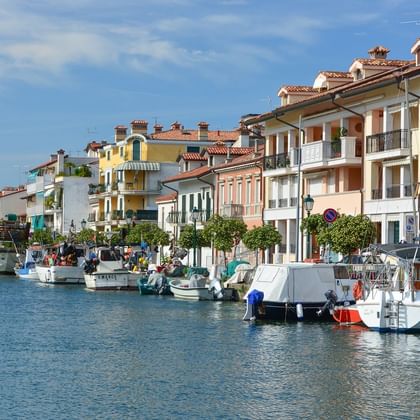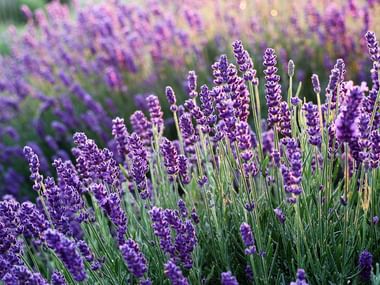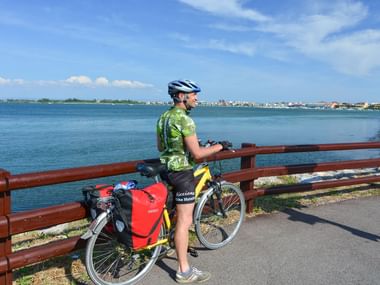In the first part of our travel report on the Alpe-Adria Cycle Route, we cycled from Salzburg to Villach.
Va bene!
We're also learning Italian: Benvenuti a Italia! Welcome to Italy!


In the first part of our travel report on the Alpe-Adria Cycle Route, we cycled from Salzburg to Villach.
Va bene!
We're also learning Italian: Benvenuti a Italia! Welcome to Italy!
After the border, the road climbs steeply up to Paradiso: a two-lane cycle path, smoothly paved with a central reservation, leads through the woods on a former railway line. A 183-kilometer section of the Ciclovia Alpe Adria through Friuli has been awarded the “Italian Green Road Award” as Italy's best cycle path. And rightly so. We roll into the street village of Tarvisio with its huge covered market, where you can buy mainly inexpensive clothing and leather goods. Many bars, cafés, enotecas, and restaurants line the street. The route climbs a little further, then we roll downhill to Pontebba with its old 19th-century boundary stone (which once marked the border between Venice and Carinthia). There is no shortage of cool former railway tunnels ranging from 80 to 950 meters in length. Today, they belong to cyclists and are partly equipped with LEDs that light up every 30 meters and electronic information boards.

In the narrow canal valley, the highway crosses high above from time to time. The country road can also be heard clearly at times. Nevertheless, the ride is very enjoyable. Several villages on the left and right of the route are worth a stop: in Malborghetto, the ethnographic museum provides information about the canal valley, Chiusafort's former railway station now houses a pub, Resiutta is home to the mining museum, and Moggio Udinense attracts visitors with the Abbey of San Gallo and the largest organ in Friuli.
It was May 6, 1976, when an earthquake almost completely destroyed the town of Venzone. An aftershock on September 15 shook the town once again. “It is thanks to a citizens' committee that Venzone was rebuilt exactly as it was,” says city guide Robert Schuhmann. Even the green double city wall from the 13th century looks like new. Lines can be seen in the masonry of some houses, dividing them into before and after the disaster. At the time, all the stones were laid out in a field and numbered. The numbered stones can still be seen on some of the house walls today. Shortly before Venzone, we cycled through Portis Vecchio. This place was apparently not so lucky. It lies deserted. The new Portis is located on the other side of the road.

“Venzone is known not only as an earthquake town, but also as a town of mummies, pumpkins, and lavender.” The latter was developed as a business idea about 30 years ago, and today many purple shops selling soap, lavender bags, and purple-painted bicycles adorn the town. Pumpkins are abundant in the area, and the pumpkin festival takes place at the end of October. “An experience!” promises Robert. Five mummies can be found in the crypt of the Chapel of San Michele. They are famous because a fungus (Hipha Bombicina Pers) prevents them from decomposing. “Il Gobbo,” the hunchback, who died in 1384, is the most famous of them. The Gothic cathedral next door was rebuilt true to the original after the earthquake.
At the Osteria e Cucina “Marcurele,” we drink a Friulano wine, a grape variety known in other parts of the world as Tokajer, which is a source of pride here, and eat Frico di Patate con Polenta (baked cheese with polenta and potatoes), a Friulian specialty. Friulian or Furlan is a distinct Rhaeto-Romanic language that is recognized as a minority language in Italy.
It is also worth taking a detour to Gemona, up to the medieval old town with its palaces, castle, and the majestic, rebuilt Cathedral of Santa Maria Assunta. This town was also severely damaged in 1976. You can learn more about this in an exhibition.

“But earthquakes only occur every 200 years on average,” says city guide Patrizia Crespi in Udine. Udine, the capital of Friuli, boasts the New Castle, built in 1556, which houses museums and an art gallery. “And with the painter Tiepolo! Many of his works can be admired in the Gallerie del Tiepolo and in the city's cathedral,” says Patrizia. The small church of Santa Maria in Castello, with the golden archangel San Daniele on top, is the city's landmark. In Piazza della Libertà, with its magnificent buildings, supposedly the most beautiful square in Venice, stands the Loggia di San Giovanni with its clock tower and two Moors, which strike the bells just like in Venice's St. Mark's Square. Here, the city pulsates with life, just like on the bustling Via Mercato Vecchio with its bars and historic taverns. It is late afternoon. In Piazza delle Erbe (Herb Square), also known as Piazza Giacomo Matteotti, people meet under the arcades and drink a tajut, a glass of wine.
The route zigzags through villages, and interesting towns follow in quick succession: The route leads straight to the huge Piazza Grande Palmanova, once planned and built as an ideal fortified town to protect against the Turks. All roads lead star-shaped to the main square so that soldiers could quickly reach the city walls. Seen from above, the outer fortification rings form a star with nine points.

Aquileia is a UNESCO World Heritage Site. The mosaics in the Basilica of Santa Maria Assunta are fascinating. The 760 square meter mosaic floor from the 4th century is considered the largest early Christian mosaic in Europe. Many symbols are depicted, because, as Alessandra Lodi explains, “Christians used a secret language.” We see Solomon's knot, in which good and evil are closely linked, the fish as a symbol of Christianity, and birds as an image of the soul. In the south hall, the battle between the rooster (light) and the turtle (darkness) is depicted. Some of the fantastical creatures are still a mystery today.
Not far from there is the ancient inland port. It was once located in a city founded by the Romans in 181 BC with 100,000 to 200,000 inhabitants, a military outpost against the barbarians and later a trading center. Excavations can be seen to the left and right: remains of the ancient harbor quay, the forum, and a mausoleum.
We cycle across the five-kilometer-long dam through the Adriatic lagoon, a sight in its own right with around 150 species of birds, and reach Grado, the former seaport of Aquileia and the Romans. Do you cycle straight to the Adriatic beach or have you already settled in at the thermal baths? No problem, Grado has its own seawater thermal baths. But first, we head into the old town. Grado is said to have been popular even in imperial times and is still a favorite destination for Austrians today. The word “Kaffeetscherl” reaches my ears. But this time we go for an Italian caffè (pronounced “kaffa”).
